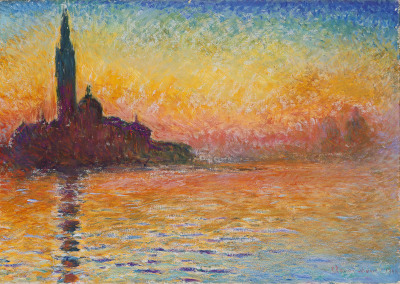The Beauty and Serenity of Sunset Art: Exploring the World of Sunset Artists
There are few things in nature as beautiful as a sunset, and artists for centuries have been well aware of this. Sunset painters have appeared in all manner of different art movements, and adapted these dreamy sunset landscapes to suit their particular artistic style.
Romanticism, with the likes of Friedrich, Turner and Constable was perhaps the most suited to colorful sunset paintings, because of their focus on landscape and seascape painting, as well as their use of light. Artists such as this were also encouraged to incorporate emotion into their work, suiting the beathtaking nature of the sun setting or rising early in the morning, or last thing at night.
Following on from the Romanticism movement, there were also a large number of Impressionist artists who included sunsets and sunrises within their paintings. Monet is perhaps the most famous of these, but in truth there in a wealth of Impressionist sunset art to enjoy, going way beyond just the French household names with which we are all so familiar.
Modernist styles have attempted to simplify landscape scenes into more abstract forms, but sunset paintings have still been common, partly because of the strong commercial value in this type of content. Many of those with just a fleeting interest in art will happily source sunset prints for their home, hoping to add some color and nature to their wall display.
From Golden Hues to Vibrant Skies: The Colors of Sunset in Art
The Impressionists discovered how color and light can change in different conditions, and how the same element can look quite differently depending on the environment around it. Likewise, the colors of a sunset can change in a similar manner, allowing artists to call upon many different tones in their palette.
Artists can experiment with cooler and warmer tones, as well as serene, vibrant and atmospheric sets of color. Depending on the stage of the sunrise or sunset, there can be a bright and impactful look to the painting, or something more to a silhouette or late night sky scene.
List of Famous Sunset Artists Throughout History: Their Legacy and Impact
Many looking for the most famous sunset paintings will look to browse the finest sunset artists, and we include a selection of them below, dating back many centuries. Many of these impressive sunset masterpieces are part of public collections and their qualities will always be best understood by viewing them in person.
Some of the artists mentioned here will have tackled the theme of sunset paintings several times in their career, and slowly developed their techniques as they went. You will also notice that many choose seascapes to capture a sunset lighting up a tranquil scene of waves lapping towards the shore. There is little in art more relaxing than a scene such as this!
Caspar David Friedrich
The famous German Romanticist painter, Caspar David Friedrich, would regularly feature single points of focus within his beautiful landscape paintings. Whilst his most famous artwork, Wanderer above the Sea of Fog, displays the majesty of his work, it does not feature either a sunrise or sunset. The artist does however make use of them in other scenes.
In Two Men Contemplating the Moon, we discover the effects of a setting sun, as we do also in Chalk Cliffs on Rügen. The deep-thinking artist often used the fading light as a symbol of the decline of humanity, as he saw it, which would perhaps be even more appropriate today. It is therefore worth mentioning that sunsets were not only used for their beauty, and the aesthetic values that they could bring to a painting, but also in the symbolism that they could represent as well.
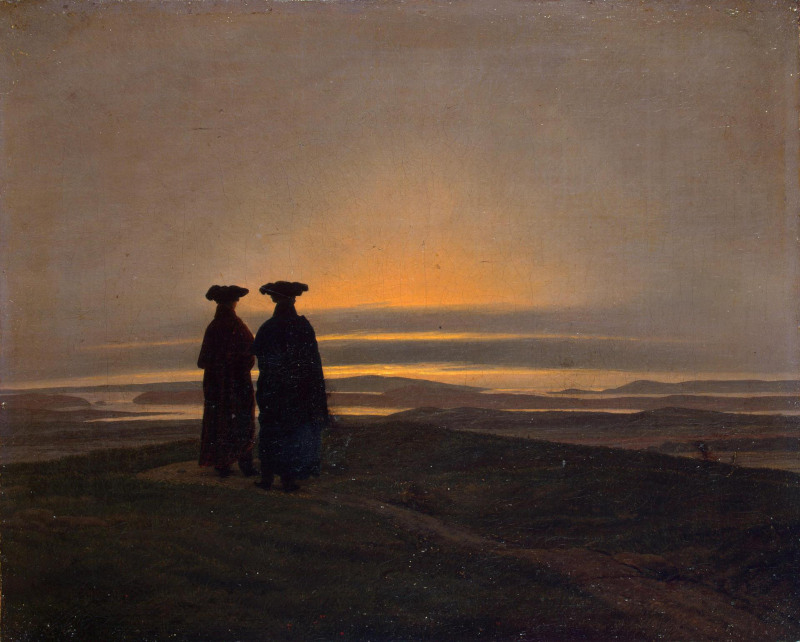 Caspar David Friedrich Sunset Painting - Evening Landscape with Two Men
Caspar David Friedrich Sunset Painting - Evening Landscape with Two Men
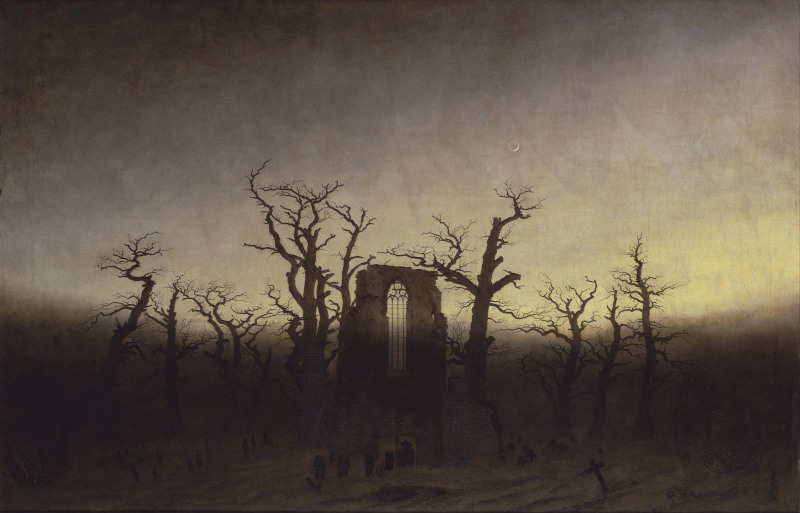 Caspar David Friedrich Sunset Painting - The Abbey in the Oakwood
Caspar David Friedrich Sunset Painting - The Abbey in the Oakwood
Claude Monet
The true master of light, Claude Monet is perhaps the most famous sunset painter in history. His oeuvre is littered with works devoted to beautiful sunrises and sunsets as he attempted to perfect his understanding of this unique natural phenomenon. Impression, Sunrise is the best known of all, and is widely recognised as the very first Impressionist painting.
San Giorgio Maggiore at Dusk, from around 1908-1912, combines the beauty of Venetian architecture with the stunning sun setting. Monet's experimental series such as his Haystacks, Rouen Cathedral and paintings within his own garden all feature the same subjects at different times of the day, and in changing seasons, thus inevitably including sunsets and sunrises within them.
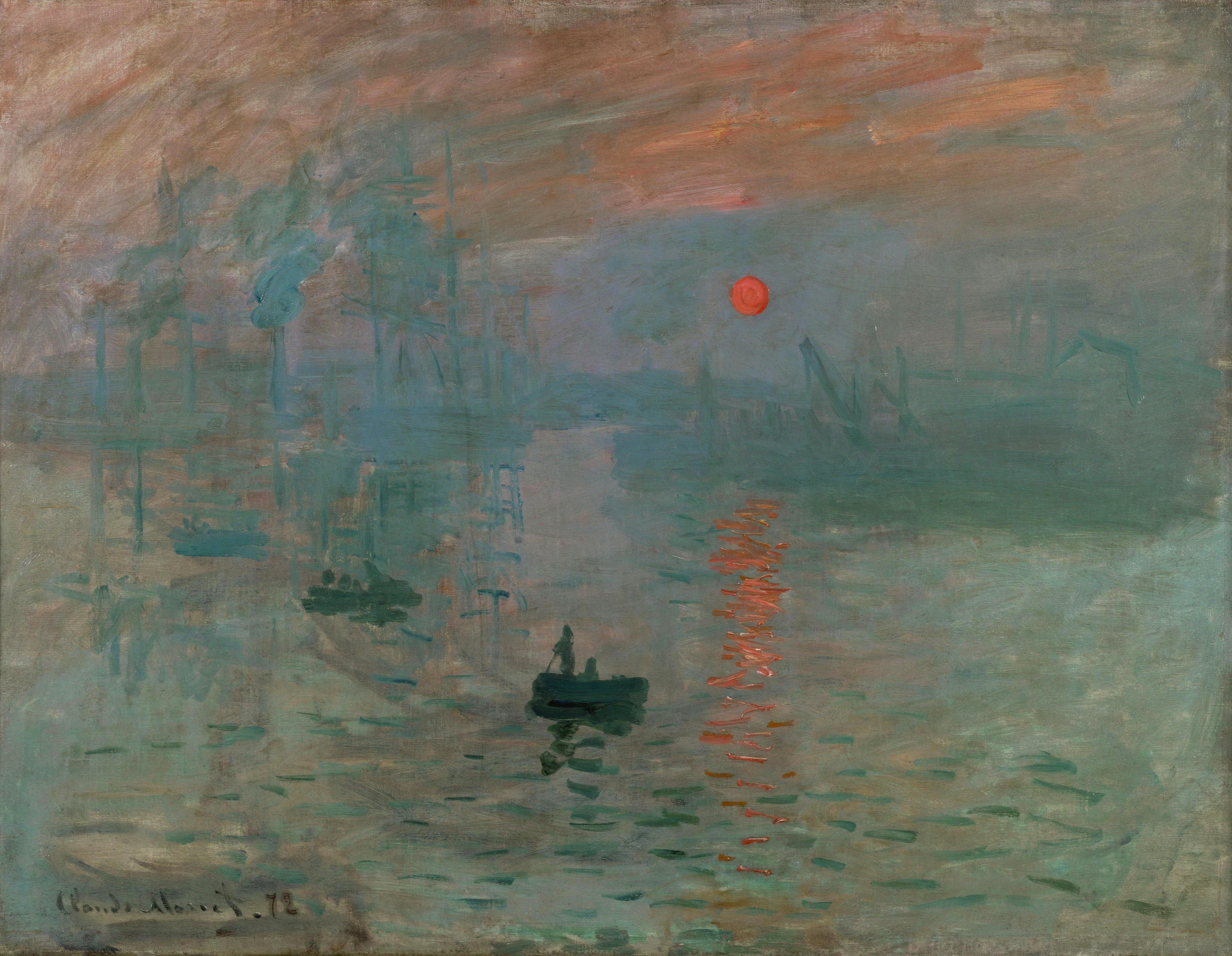 Claude Monet Sunrise Painting - Impression, Sunrise
Claude Monet Sunrise Painting - Impression, Sunrise
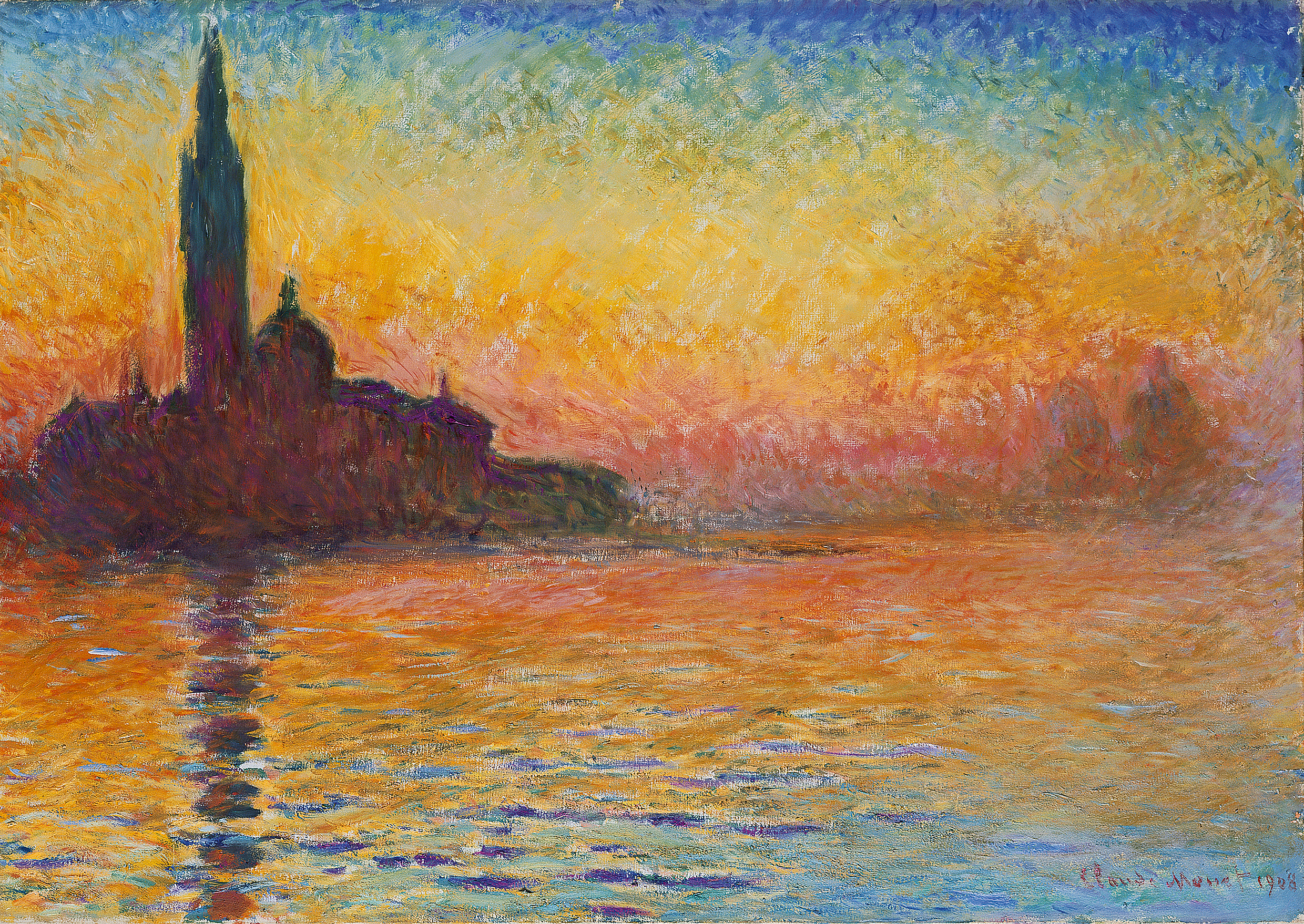 Claude Monet Sunset Painting - San Giorgio Maggiore at Dusk
Claude Monet Sunset Painting - San Giorgio Maggiore at Dusk
Claude Lorrain
Prior to the Impressionist and Romanticist sunset painters, there was relatively little landscape art to be found. It took the influence of Claude Lorrain to start to change that, and this Baroque painter helped to establish landscape art as a major genre for the first time. Inevitably, as he experimented with light and color, sunsets and sunrises would appear frequently within his work.
Pastoral Landscape with the Setting Sun, Aeneas at Delos, Seaport at Sunrise and Seaport at Sunset are four good examples of Lorrain's career. Each provide a resplendent array of color and offer clear evidence of the influence that this artist would have on the later Impressionist era. His paintings proved popular in the UK, helping to inspire young British landscape painters who, in turn, would encourage their French counterparts to continue the spread of this popular genre.
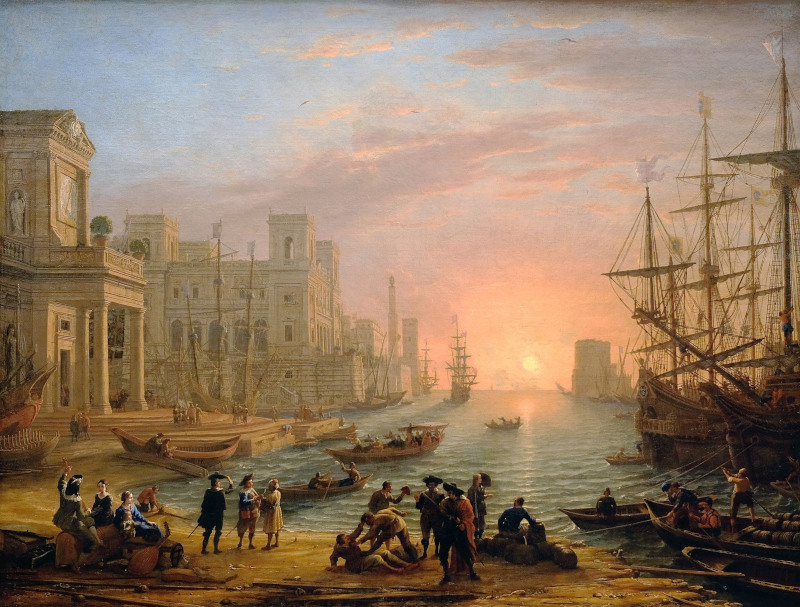 Claude Lorrain Sunset Painting - Seaport at Sunset
Claude Lorrain Sunset Painting - Seaport at Sunset
J.M.W. Turner
William Turner was a true master of light in art, and can be considered one of the most famous sunset landscape painters. Many of his seascapes featured an extraordinary luminosity, and survey of atmospheric conditions which would inspire a number of French Impressionist artists when visiting London in the 19th century.
Fighting Temeraire displays many of these qualities, as an old ship is tugged away on its final voyage. Perhaps the fading light represents the final moments of the ship itself. The artist also travelled across continental Europe and captured the beauty of Venice in a number of artworks, some of which feature sunsets themselves.
This skilled technician also produced large amounts of watercolor sunset art, filling small sketchpads with landscape scenes. Watercolor paintings were popular across the UK during the era of Turner, with landscape scenes well suited to this genre. See also Snow Storm: Hannibal and his Army Crossing the Alps and Peace - Burial at Sea for further examples of Turner's experimentations with light in oils.
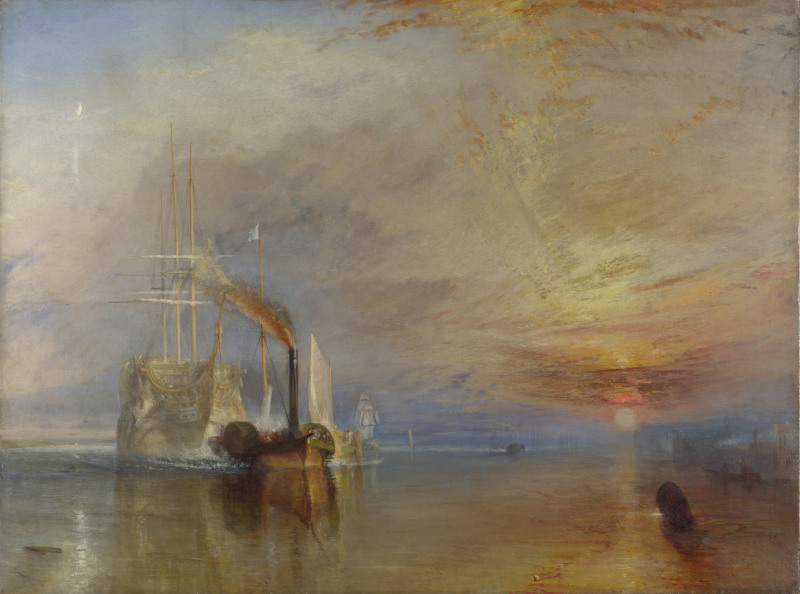 William Turner Sunset Painting - Fighting Temeraire
William Turner Sunset Painting - Fighting Temeraire
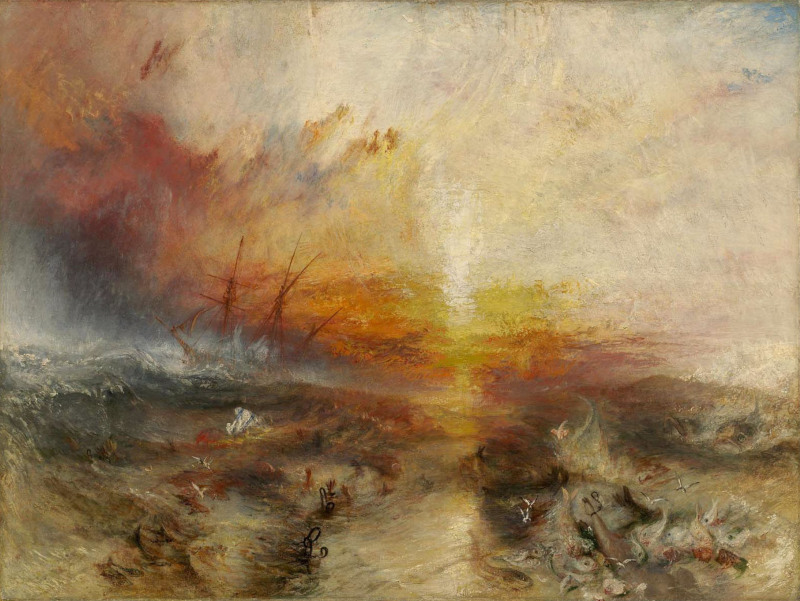 William Turner Sunset Painting - The Slave Ship
William Turner Sunset Painting - The Slave Ship
Vincent van Gogh
Van Gogh used bright and bold color schemes after his move to France. It was here that his time in a light-saturated environment would alter his artistic direction. Sunsets would ineviably appear within that, with skies being a particularly important section of Van Gogh's compositions, as seen in Starry Night.
The Red Vineyard, Landscape at Dusk and Willows at Sunset show different interpretations by this famous Dutch painter, and notice how he chooses landscapes rather than seascapes in most cases. His expressionist nature was ideally suited to the bright, warm tones brought about by these expressive sunset canvases, taking things onwards from the earlier Impressionists.
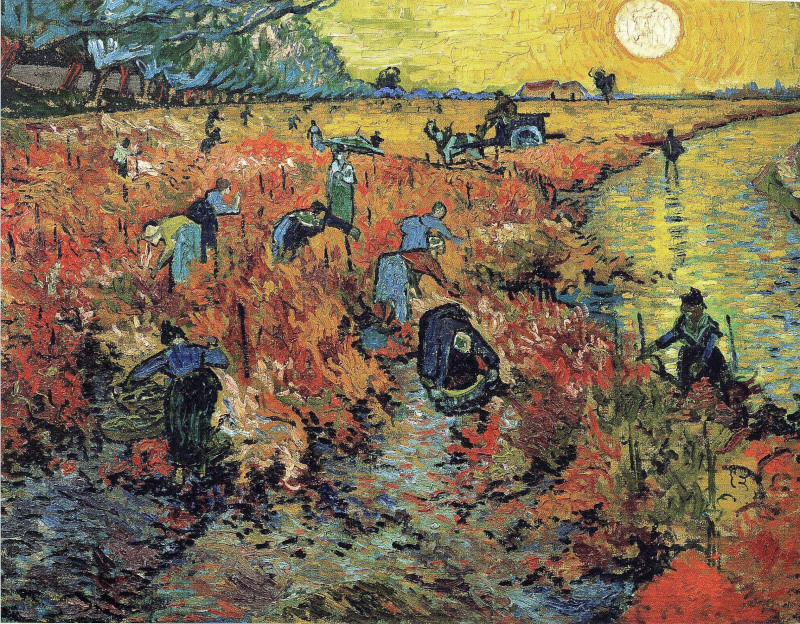 Vincent van Gogh Sunset - The Red Vineyard
Vincent van Gogh Sunset - The Red Vineyard
Camille Pissarro
Sunset at Eragny is one example of Pissarro's use of sunsets in his work. This Frenchman would become one of the most important members of the Impressionist movement and specialised in landscape painting, just as with most of his colleagues.
That particular piece features a row of trees spread horizontally across the canvas. The sun then lurks just above the horizon, with fading light bringing shadows into the scene. The artist would have had to work quickly to capture the unique effects which occur at this time of the day, but only for a short few moments.
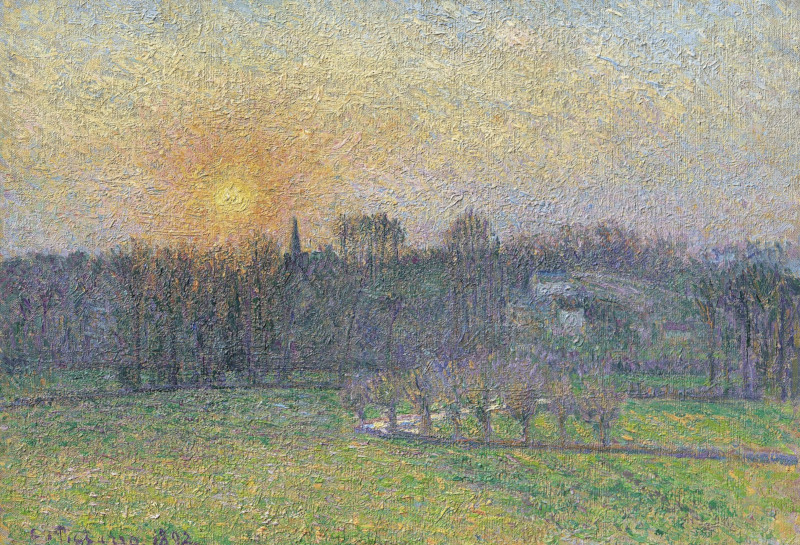 Camiile Pissarro Impressionist Sunset - View of Bazincourt, Sunset
Camiile Pissarro Impressionist Sunset - View of Bazincourt, Sunset
Edvard Munch
Edvard Munch incorporated expressive, bright skies in many of his paintings, including The Scream. His idea for this work came whilst walking around Norway and viewing a beautiful sunset. Anxiety and The Sun offer a similarly impactful use of natural light and are perfectly suited to the Expressionist movement.
Munch might not be considered a traditional landscape painter, but in a similar manner to Van Gogh, he would still find a beauty within his skies, often as a background behind a portrait. He would rarely seek accuracy to reality, and instead use the sky to portray a mood or atmosphere which would spread throughout the rest of the painting.
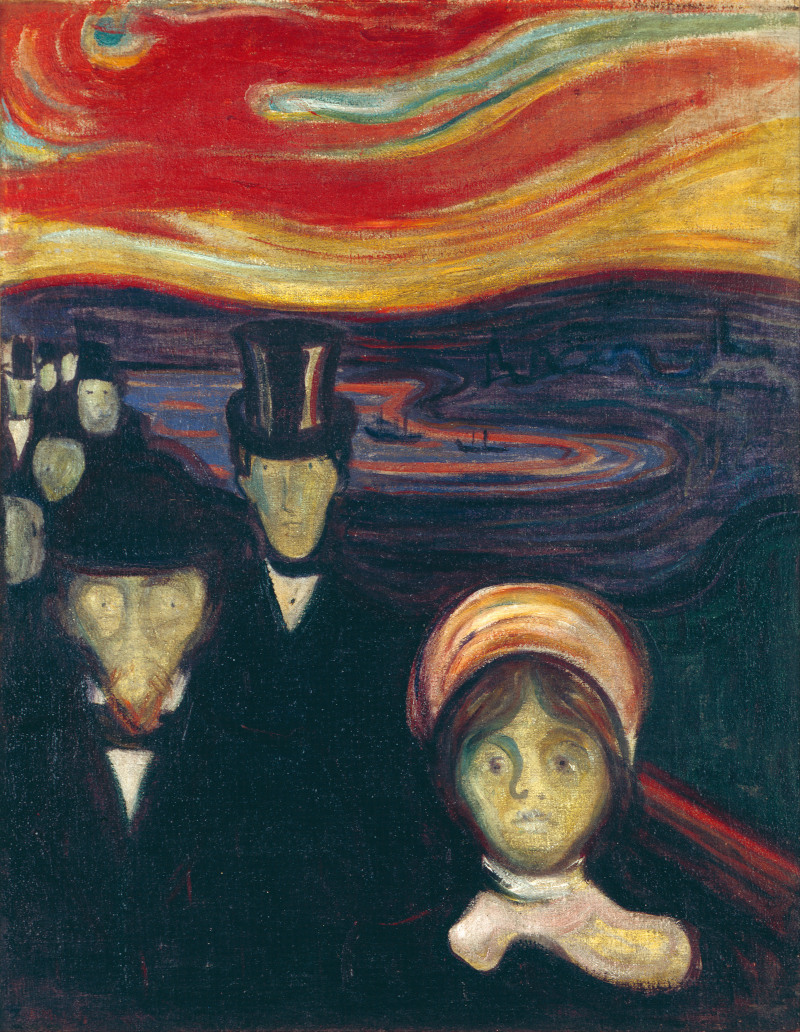 Edvard Munch Expressionist Sunset Painting - Anxiety
Edvard Munch Expressionist Sunset Painting - Anxiety
Thomas Cole
Thomas Cole was a founder of the Hudson River School and specialised in landscape painting. He would produce many American sunset paintings within his career which captured the beauty of this young country. He would find other like-minded artists who worked in a broadly similar manner and shared his love of the outdoors.
Cross at Sunset and Sunset, View on the Catskill arrived fifteen years apart as Cole continued to experiment with light in his work right across his career. He remains one of the most important American painters in history and his legacy continues to remain strong all these years later.
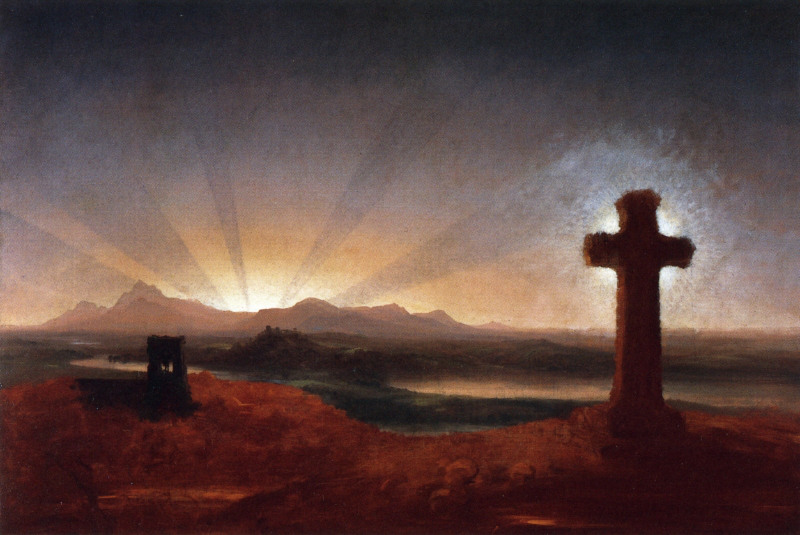 Thomas Cole Hudson River School Sunset - Cross at Sunset
Thomas Cole Hudson River School Sunset - Cross at Sunset
Frederic Edwin Church
Church was another excellent addition to the Hudson River School and was remembered for his huge canvases in which incredible detail was delivered. His content often featured mountains, waterfalls, and sunsets, and he held a great passion for the natural landscape, hoping to encourage others to respect it too.
Our Banner In The Sky (1861) was produced to help raise money for injured soldiers and this artwork makes use of a stunning sunset which lays behind a patriotic foreground and a fluttering US flag. This piece immediately strikes a chord with American art followers and retains its popularity today.
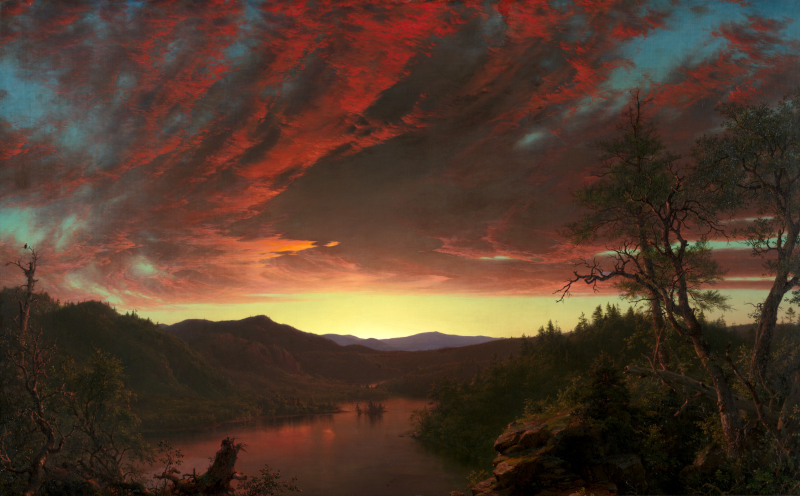 Frederic Edwin Church Sunset Landscape - Twilight in the Wilderness
Frederic Edwin Church Sunset Landscape - Twilight in the Wilderness
Albert Bierstadt
Another member of the Hudson River School movement, Albert Bierstadt possessed a passion for the natural landscape of the US, and also worked hard to help protect it. This painter was highly gifted, able to cover large scenes with precise technical control. His sprawling landscapes would often feature individual animals and carefully crafted trees.
Sunrise on the Matterhorn features subdued lighting, with other examples including Sunrise on Mount Tacoma, Sunset on the Rockies and Sunset in the Yosemite Valley, with Bierstadt completing a huge number of paintings by the end of his career.
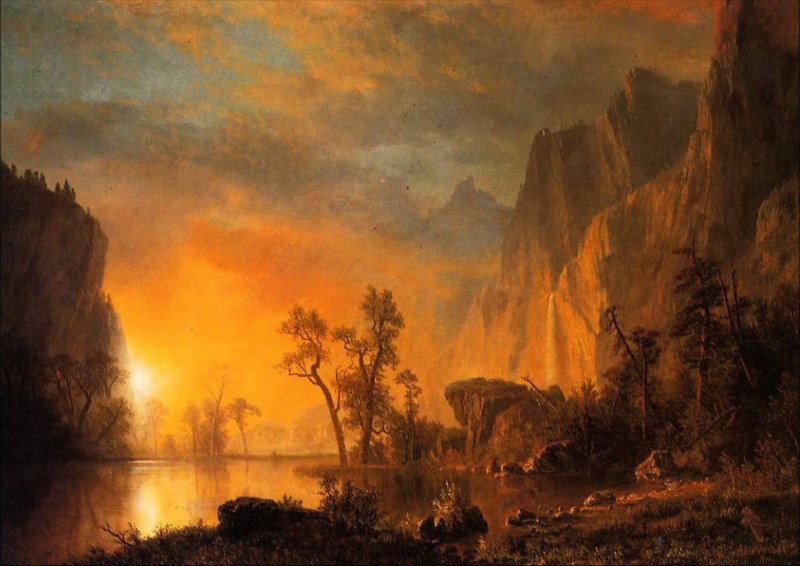 Albert Bierstadt American Landscape Sunset - Sunset in the Rockies
Albert Bierstadt American Landscape Sunset - Sunset in the Rockies
Mastering the Brushstrokes: Techniques and Styles of Sunset Artists
The brushstrokes of Vincent van Gogh famously appear visible on each canvas, in a similar manner to how the Pointilist artists would generate an image with individual dabs of paint. This Dutchman would leave thick strokes of paint and deliberately avoided blending them in together.
The earlier movements, prior to the Impressionists, would fuse strokes together to create photo-realistic iamges. Leonardo had developed this approach, and it continued for centuries after, until finally more expressive approaches would be taken. The Realism movement was also based on accuracy and the depiction of reality, and was popular in the 19th century.
Capturing the Transience of Dusk: Emotions and Symbolism in Sunset Art
Sunsets and sunrises can offer great symbolic meaning to a painting. They can represent a single moment in time, which an artist can capture forever with some brisk brushwork. There is also an almost infinite gradient of color, from light to dark, as this transition occurs. It truly is a natural beauty which is hard to replicate accurately, and only the best technicians have managed to do so.
The style of the artist's work can deliver different atmospheres. Plein air sunset painters can work vigorously to create a feeling of movement, whilst others will blend their tones in a subtle manner and create a more tranquil atmosphere. With regards dusk, a dark palette is not suited to every artist, but some who have experience in these darker tones should be able to deliver something breaktaking.
Contemporary Sunset Art: Pushing Boundaries and Challenging Conventions
Contemporary sunset art is particularly inventive, as artists have attempted to experiment with all manner of different materials, helping them to achieve many different results. Traditional art is far less experimental, choosing oils and watercolors in most cases.
Some contemporary artists can go even further, relying on light or sound to capture a piece of art. Some might use newspapers or natural objects such as tree bark, sand, or stone. Modern art is the most free of art forms up to now, and digital art, including photography, looks to be the next exciting chapter in the evolution of western art, after many centuries of changes and new ideas dating back to the Renaissance and even before that.
Nature's Masterpiece: How Sunsets Inspire and Influence Artists
In today's modern world, many citizens are feeling a greater disconnect from nature. The solution for some is to enjoy pictures of it within their own homes, such as on a device, or with a print hanging on their wall. Artists likewise use historical sunset paintings to inspire their own creative ideas.
A browse of the sunset paintings above will show how artists have taken what has gone before and re-invented similar content within new art movements. The natural flow passed from Baroque art to the Romanticist era, before leading on to the Impressionists and the modern art that followed.
The Science of Sunsets: Understanding the Interplay of Light and Atmosphere in Art
As the sun moves, its light will reflect through different atmospheres. This brings different lengths of light, which will then vary across the sky and provide a beautiful image. This can provide palettes of warm and cold tones, including oranges, yellows, purples and blues. These will also interact with other parts of the scene in an infinite number of ways.
Golden or magic hour are terms used to describe perhaps the most exciting period of a sunset or sunrise, just as the sun is balanced at the level of the horizon. It is here that the most exciting light effects are normally witnessed, and artists will often try to work quickly to capture precisely this moment.
Creating Depth and Atmosphere: Composition Techniques in Sunset Art
Artists will typically produce depth in a painting by sectioning the composition into foreground, middle and background. They may move elements around in order to make this separation clearer, even if that takes the painting away from what they have viewed in reality.
Natural elements can be used to create a sense of perspective. Winding rivers are one of the most common, where different depths of the painting can be tied together. Mountains can also be added to the background, with small animals or people displayed in the foreground. Tones can also vary from the front to back, just as occurs in real life when viewing a landscap panorama.
The varying tones of the sunset itself can also be used to create an atmosphere, whilst the light can also reflect differently on different surfaces, helping to better portray elements such as rock, wood, water and more.
From Realism to Abstraction: Exploring Different Artistic Approaches to Sunsets
The beauty of a sunset has been used in a wide variety of styles, covering a number of different art movements. Just the images included in this article on sunset artists touches on the likes of Impressionism, Expressionism, Romanticism and Baroque art. Beyond that, there have also been many modern art sunsets too, across the 20th century, leading up to the present day.
The one thing these approaches all have in common is how they make use of the bright tones of the sunset. Their interpretations can then mirror reality or provide more abstrcat versions that are still understood by the viewer, even with just a few shapes and tones. One can track sunset paintings over time to see a visual transition in European and American art, from precision and accuracy to feeling and emotion.
The Rise of Digital Sunset Art: Exploring Technological Innovations in the Medium
Sunset pictures and photographs can lift one's mood in an instant. It is unsurprising, therefore, to see a rise in digital sunset art, where people have added images of these great paintings to their screens at home. When hard at work it can be a treat to enjoy some of these bright colors, delivered in a natural environment.
Some will even use digital art sunsets and print them at home, allowing a cheap method to fill their walls. Again, color is key here and the brightness of a sunset can really lift a room. The variety of artists who have addressed this theme also allows different tastes to be met, when choosing a suitable sunset print or painting.
The Business of Sunset Art: Navigating the Market and Promoting Artists' Work
There remains a huge interest in sunset art, often in the form of digital or printed art prints. Even those unfamiliar with art history may well appreciate the bright tones and majestic atmosphere of a sunset print for their home, with this topic therefore being incredibly mainstream and accessible to all.
Many art fans will simply pick by aesthetic value, and so sunset artists must work to get their photographs or prints in front of as many people as possible - they will quickly work out which of their artworks are more popular and can adjust their advertising accordingly. In terms of online, abstract and modern sunset artworks are currently proving particularly popular, with contemporary sunset artists performing well with younger audiences.



